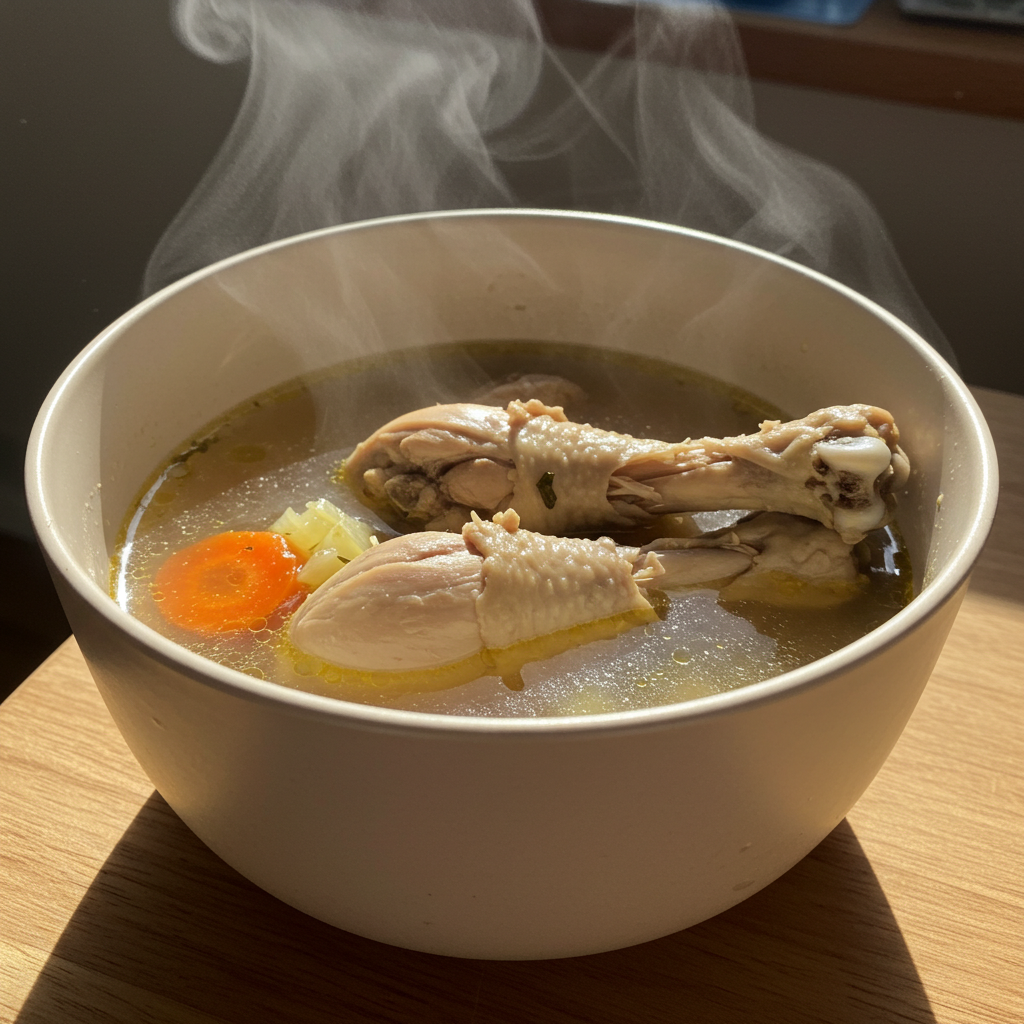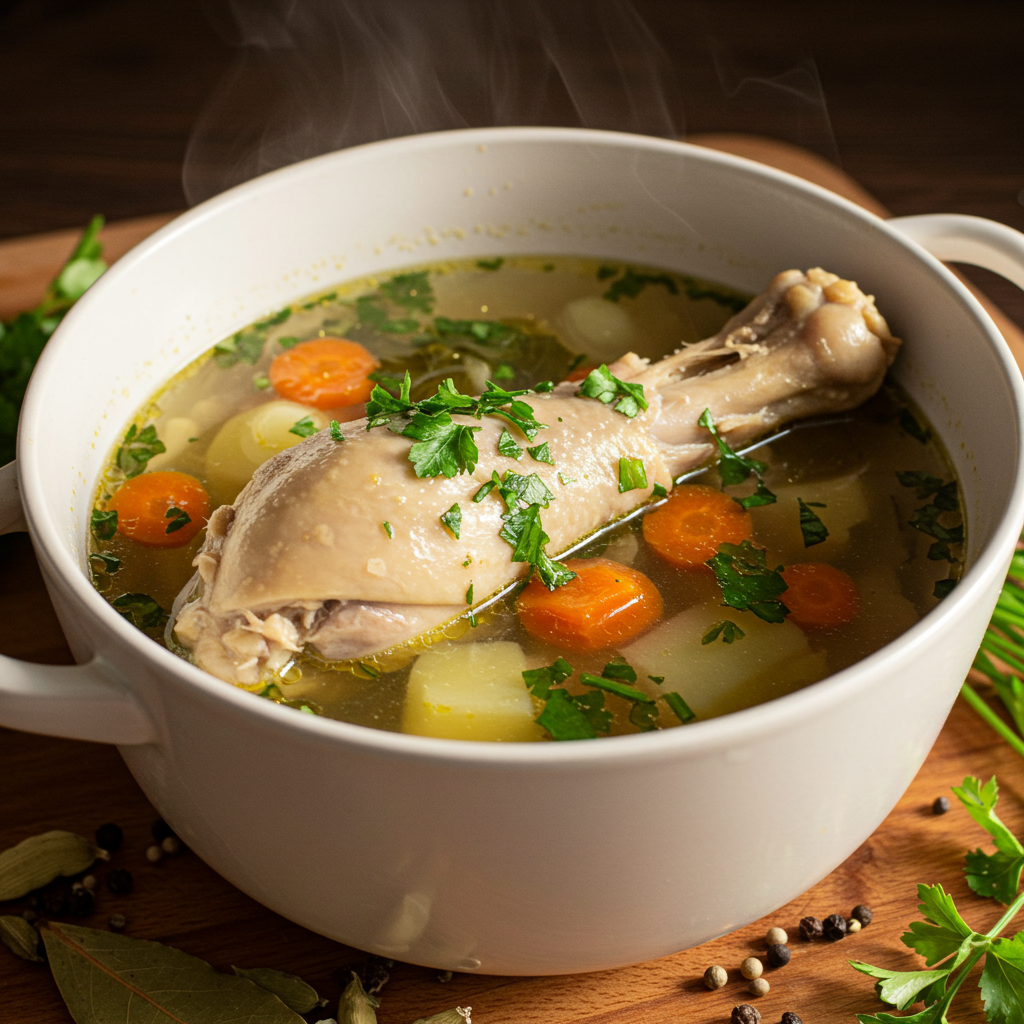Introduction to Chicken Leg Soup
Chicken leg soup stands as one of the most comforting and nourishing meals across many cultures. From grandmothers’ kitchens to high-end restaurants, this humble dish brings warmth and healing properties to tables worldwide. The magic lies in using chicken legs specifically – they create richer, more flavorful broths than other chicken parts.
Many home cooks overlook chicken legs in favor of breasts, but professional chefs consistently choose dark meat for creating the most flavorful soups. The legs contain more connective tissue and fat, which break down during cooking to release deep flavors and beneficial nutrients. These same properties make chicken leg soup a go-to remedy for colds and flu symptoms, with research backing up what our grandmothers always knew.
When you make homemade chicken leg soup, you join a tradition that spans centuries and crosses continents. Every culture has its version – from classic American chicken noodle to Thai tom kha gai. In this comprehensive guide, we’ll show you how to make the perfect chicken leg soup for any occasion. You’ll find tips for creating stock from scratch and discover why this humble soup deserves a regular spot in your meal rotation.

The Foundation of Flavor: Why Chicken Legs Make Excellent Soup
The Anatomy of Chicken Legs
Chicken legs consist of two distinct parts:
- Drumsticks – the lower portion with a single bone
- Thighs – the upper section with more meat and complex bone structure
These cuts contain several elements that make them perfect for soup:
- Rich bone marrow that seeps into the broth
- Abundant collagen that transforms into gelatin
- Well-distributed fat that adds flavor and mouthfeel
The bones in chicken legs aren’t just structural – they’re flavor powerhouses. When simmered slowly, they release minerals and compounds that create that distinctive chicken soup taste we all recognize. The marrow inside these bones contains fat, protein, and nutrients that dissolve into your broth.
Nutritional Profile of Chicken Legs
Chicken leg meat offers substantial nutritional benefits:
- Protein: Higher content than chicken breast (about 24g per leg)
- Fat: Contains beneficial monounsaturated fats
- Minerals: Rich in iron, zinc, and selenium
- Vitamins: Good source of B vitamins, especially B6 and B12
The dark meat in chicken legs contains more iron and zinc than white meat. These minerals support immune function and help your body produce energy. When you make chicken leg soup, these nutrients infuse into the broth, creating a truly nourishing meal.
The fat content in chicken legs gets a bad reputation, but it serves important purposes in soup-making. It carries flavor compounds that would otherwise remain locked in the meat. It also helps your body absorb fat-soluble vitamins from the vegetables you add to your soup.
Essential Preparation Techniques
Cleaning and Preparing Chicken Legs
Start with proper preparation to make the best chicken leg soup:
- Rinse chicken legs under cold water
- Pat dry with paper towels
- Remove excess fat with kitchen shears
- Check for pin feathers and remove them
Many recipes debate whether to keep the skin on or off. The skin adds richness and flavor but also increases fat content. For a clearer broth, remove the skin. For maximum flavor, leave it on and skim the fat later.
For the clearest broth, some chefs recommend blanching the chicken legs first. This involves:
- Placing legs in cold water
- Bringing to a boil for 2-3 minutes
- Draining and rinsing
- Starting fresh with new water
This technique removes impurities that can cloud your broth, resulting in a cleaner-tasting chicken soup.
Pre-Cooking Methods for Enhanced Flavor
The way you treat chicken legs before they hit the soup pot makes all the difference in your final chicken leg soup flavor. Try these methods to boost taste:
Browning Method
Before making soup, brown your chicken legs to create deeper flavors:
- Heat 1 tablespoon oil in a large pot
- Place chicken legs skin-side down
- Cook until golden brown (about 5 minutes per side)
- Add your soup ingredients to the same pot
This simple step triggers the Maillard reaction, a chemical process that creates new flavor compounds. The browned bits stuck to the pot bottom (called “fond”) dissolve into your broth, adding rich taste to your chicken soup.
Roasting Method
Roasting chicken legs before simmering them adds another dimension of flavor:
- Preheat oven to 400°F (200°C)
- Place chicken legs on a baking sheet
- Drizzle with olive oil and sprinkle with salt
- Roast for 25-30 minutes until golden
The caramelization from roasting adds sweetness and depth to your homemade chicken soup. This works especially well for heartier winter soups.
Marinating Magic
Marinating chicken legs for 2-4 hours before cooking infuses them with flavor:
- Simple marinade: Lemon juice, garlic, and herbs
- Asian-inspired: Soy sauce, ginger, and green onions
- Mediterranean: Olive oil, oregano, and lemon zest
Even a quick 30-minute soak in these mixtures will improve your soup’s taste profile. The acids in marinades also help tenderize the meat, making it fall off the bone in your chicken leg soup.

Stock vs. Broth: Understanding the Difference
Many people use the terms “stock” and “broth” interchangeably, but they differ in key ways:
Chicken Leg Stock
Chicken stock focuses on extracting flavor from bones:
- Simmers for longer periods (4-6 hours)
- Uses mostly bones with less meat
- Contains no salt or minimal seasoning
- Results in a gelatin-rich liquid
The long cooking time pulls collagen from chicken leg bones, which transforms into gelatin. This gives stock its body and rich mouthfeel. You’ll know you’ve made a good stock when it solidifies in the refrigerator due to high gelatin content.
Chicken Leg Broth
Chicken broth emphasizes meat flavor:
- Cooks for shorter periods (1-2 hours)
- Uses meaty chicken legs
- Includes salt and seasonings
- Produces a flavorful ready-to-drink liquid
Broth serves as a finished product you can enjoy immediately. The meat stays tender since it doesn’t cook as long. For the best soup, many chefs make stock first, then turn it into broth by adding meat and seasonings.
You can create amazing slow cooker chicken soup using either method. The slow cooker works perfectly for drawing out flavors over many hours.
Classic Chicken Leg Soup Recipes
Traditional Chicken Noodle Soup
Nothing beats classic chicken noodle soup made with chicken legs:
Ingredients:
- 4 chicken legs
- 2 carrots, diced
- 2 celery stalks, diced
- 1 onion, diced
- 2 garlic cloves, minced
- 8 cups water
- 2 bay leaves
- 1 teaspoon thyme
- 8 oz egg noodles
- Salt and pepper to taste
- Fresh parsley for garnish
Quick Method:
- Brown chicken legs in the pot
- Add vegetables and cook for 5 minutes
- Pour in water and add herbs
- Simmer for 45 minutes
- Remove chicken, shred meat, discard bones
- Return meat to pot
- Add noodles and cook until tender (about 8 minutes)
- Adjust seasonings
This traditional chicken soup recipe works perfectly for cold days or when someone feels under the weather. The egg noodles absorb the rich chicken flavor, creating a complete meal in one bowl.
Asian-Inspired Chicken Leg Soups
Asian cuisines offer amazing ways to transform chicken legs into healing, flavorful soups. Each region brings unique ingredients and techniques to create distinctive tastes.
Chinese Herbal Chicken Leg Soup
Chinese cooks often add medicinal herbs to chicken soup for extra health benefits:
Ingredients:
- 4 chicken legs
- 8 cups water
- 3 slices fresh ginger
- 4 garlic cloves
- 2 star anise
- 1 cinnamon stick
- 1 tablespoon goji berries
- 3 dried red dates (jujubes)
- 1 bunch green onions
- Salt to taste
Method:
- Blanch chicken legs in boiling water for 2 minutes
- Rinse under cold water
- Add all ingredients to a pot
- Bring to a boil, then reduce heat
- Simmer for 1.5 hours
- Remove chicken, shred meat, return to soup
- Serve hot
This soup combines the richness of chicken leg meat with the healing powers of traditional Chinese herbs. Many Chinese families make this soup during winter months or when recovering from illness.
Thai Tom Kha Gai with Chicken Legs
This creamy, tangy Thai chicken soup uses coconut milk and aromatic herbs:
Ingredients:
- 4 chicken legs
- 4 cups chicken broth
- 2 cups coconut milk
- 4 slices galangal (or ginger)
- 2 lemongrass stalks, bruised
- 4 kaffir lime leaves
- 1 cup mushrooms, sliced
- 2 tablespoons fish sauce
- 3 tablespoons lime juice
- Thai chilies to taste
- Fresh cilantro for garnish
Method:
- Simmer chicken legs in broth for 30 minutes
- Remove chicken, shred meat, discard bones
- Add coconut milk, galangal, lemongrass, and lime leaves to broth
- Simmer for 10 minutes
- Add mushrooms and chicken meat
- Cook for another 5 minutes
- Turn off heat, add fish sauce and lime juice
- Garnish with chilies and cilantro
The creamy coconut base balances perfectly with tangy lime and savory chicken leg flavor. This soup works well for both cold winter nights and hot summer days.
Japanese Chicken Leg Ramen Base
Create authentic ramen soup at home using chicken legs:
Ingredients:
- 4 chicken legs
- 2 onions, halved
- 2 carrots, roughly chopped
- 1 apple, quartered
- 4 garlic cloves
- 1-inch ginger piece
- 2 tablespoons soy sauce
- 10 cups water
- 2 tablespoons sesame oil
Method:
- Heat sesame oil in a large pot
- Brown chicken legs on all sides
- Add vegetables, apple, and aromatics
- Pour in water and bring to a boil
- Reduce heat and simmer for 3 hours
- Strain broth and add soy sauce
- Serve with ramen noodles and toppings
The apple adds natural sweetness that balances the rich chicken leg broth. This base works for many different ramen styles – just add your favorite toppings and noodles.

Mediterranean Chicken Leg Soups
Mediterranean soups often feature bright flavors and interesting textures alongside chicken.
Greek Avgolemono with Chicken Legs
This creamy Greek chicken soup gets its silky texture from eggs and lemon:
Ingredients:
- 4 chicken legs
- 8 cups water
- 1 onion, diced
- 2 carrots, diced
- 1 cup rice (or orzo pasta)
- 3 eggs
- Juice of 2 lemons
- Fresh dill for garnish
- Salt and pepper to taste
Method:
- Cook chicken legs in water with vegetables for 45 minutes
- Remove chicken, shred meat, return to soup
- Add rice and cook until tender
- In a bowl, whisk eggs until frothy
- Whisk in lemon juice
- Slowly add 2 cups of hot broth to egg mixture while whisking
- Pour egg mixture back into soup
- Stir gently until soup thickens
- Garnish with fresh dill
The egg-lemon mixture creates a velvety texture that coats the chicken meat perfectly. This soup tastes both rich and light at the same time.
Italian Stracciatella with Chicken Legs
This Italian egg-drop soup gains extra flavor from chicken legs:
Ingredients:
- 3 chicken legs
- 8 cups water
- 1 onion, quartered
- 1 carrot, chopped
- 1 celery stalk, chopped
- 3 eggs
- 1/4 cup grated Parmesan cheese
- 2 tablespoons semolina flour
- 2 tablespoons fresh parsley, chopped
- Salt and pepper to taste
Method:
- Make broth with chicken legs and vegetables (1 hour)
- Strain broth and return to pot
- Shred chicken meat and return to broth
- Bring soup to a gentle simmer
- Mix eggs with cheese, semolina, and parsley
- Slowly pour egg mixture into simmering soup while stirring
- The egg forms “little rags” (stracciatella) in the soup
- Serve immediately
This elegant soup turns simple ingredients into a delicate first course. The eggs create soft ribbons throughout the rich chicken broth.
Herbs and Spices That Complement Chicken Leg Soup
The right herbs and spices can transform basic chicken leg soup into something truly special. These flavor boosters add aroma, depth, and often bring their own health benefits.
Classic Herb Combinations
Traditional chicken soup herbs create familiar, comforting flavors:
- Bouquet Garni: Bundle of thyme, parsley, and bay leaf
- Poultry Seasoning: Sage, thyme, marjoram, rosemary, and black pepper
- French Mirepoix: Onions, carrots, and celery as an aromatic base
Fresh herbs add brightness when added at the end of cooking. Dried herbs work better when they simmer with the soup for longer periods. A good rule: use 1 teaspoon dried herbs for every tablespoon of fresh.
For the classic chicken soup flavor you remember from childhood, try this simple herb blend:
- 1 bay leaf
- 1 teaspoon dried thyme
- 1 tablespoon fresh parsley
- 1/4 teaspoon black pepper
- 1 teaspoon salt
Add these during the last 30 minutes of cooking for the best flavor profile.
Global Spice Profiles
Different cultures use signature spice combinations in their chicken leg soups:
Middle Eastern:
- Cumin
- Turmeric
- Cinnamon
- Cardamom
- Mint
Indian:
- Garam masala
- Turmeric
- Ginger
- Coriander
- Cumin
Latin American:
- Cilantro
- Cumin
- Oregano
- Chili powder
- Lime
Eastern European:
- Paprika
- Dill
- Caraway
- Marjoram
- Sour cream (as garnish)
Try adding just one new spice to your regular chicken leg soup recipe. This simple change can create a whole new dish without much effort.
Healing Herbs and Spices
Many herbs and spices add medicinal qualities to chicken leg soup:
- Ginger: Fights nausea and inflammation
- Garlic: Contains antimicrobial compounds
- Turmeric: Reduces inflammation
- Thyme: Supports respiratory health
- Sage: Soothes sore throats
When you feel sick, a chicken soup with these healing additions works better than plain broth. The combination of chicken nutrients and herbal benefits creates truly healing food.
Vegetables and Starches for Chicken Leg Soup
Best Vegetable Pairings
Vegetables add nutrients, texture, and color to chicken leg soup:
Root Vegetables:
- Carrots
- Parsnips
- Turnips
- Sweet potatoes
- Rutabaga
Greens:
- Kale
- Spinach
- Swiss chard
- Cabbage
- Bok choy
Other Great Additions:
- Mushrooms
- Corn
- Peas
- Bell peppers
- Tomatoes
Add hearty root vegetables during the main cooking process. Save quick-cooking greens for the last 5-10 minutes to keep their color and nutrients.
For a nutrient-rich chicken soup, try this vegetable combination:
- Carrots and celery (add at beginning)
- Sweet potatoes (add halfway through)
- Kale or spinach (add in last 5 minutes)
Grains and Noodles
Starches make chicken leg soup more filling and absorb the wonderful broth flavors:
Popular Grains:
- Rice (white, brown, or wild)
- Barley
- Quinoa
- Farro
- Bulgur wheat
Noodle Options:
- Egg noodles
- Rice noodles
- Udon
- Soba
- Orzo
Cook grains and pasta separately before adding them to your soup. This stops them from soaking up too much broth and becoming mushy when stored.
For busy weeknights, try this time-saving tip: Make a big batch of plain chicken leg broth, then portion and freeze it. When ready to eat, thaw the broth, add fresh vegetables and pre-cooked grains for a quick meal.

Health Benefits of Chicken Leg Soup
Immune-Boosting Properties
Chicken leg soup truly helps fight colds and flu. Here’s why:
- Increased Hydration: Warm broth helps maintain fluid balance
- Improved Mucus Flow: Steam helps clear congestion
- Anti-inflammatory Effects: Ingredients reduce swelling in airways
- Nutrient Delivery: Easy-to-digest form of important vitamins and minerals
The amino acid cysteine in chicken helps thin mucus. The slow cooking process releases this compound into the broth, making it easier to cough up congestion.
A bowl of hot chicken soup also slows white blood cells that cause inflammation during colds. This scientific finding supports the age-old wisdom that chicken soup helps you feel better when sick.
Joint and Skin Health Benefits
The collagen in chicken leg soup supports:
- Stronger Joints: Gelatin helps rebuild cartilage
- Reduced Joint Pain: Anti-inflammatory compounds ease discomfort
- Healthier Skin: Collagen improves skin elasticity
- Better Gut Lining: Gelatin supports digestive tract healing
- Stronger Hair and Nails: Amino acids provide building blocks
When you simmer chicken legs for hours, you extract collagen from the bones and connective tissues. This collagen breaks down into gelatin, which your body can use more easily.
Regular consumption of homemade bone broth from chicken legs may help reduce joint pain and improve skin appearance over time. Many people report these benefits after adding broth to their weekly diet.
Digestive Health Advantages
Beyond immune and joint benefits, chicken leg soup supports your digestive system:
- Easy to Digest: The long cooking process breaks down proteins
- Gut-Healing Properties: Gelatin coats and soothes the digestive tract
- Hydration: Warm broth helps maintain fluid balance
- Gentle Nutrition: Perfect for sensitive stomachs during illness
- Appetite Stimulation: Aromatic qualities increase hunger when recovering
The natural gelatin in chicken leg broth helps protect the lining of your digestive tract. This may reduce symptoms of leaky gut and improve nutrient absorption.
Many doctors recommend clear broths during stomach upsets for good reason. The warm liquid moves easily through your system while providing essential nutrients. Chicken soup offers more substance than plain water but remains gentle on your stomach.
Troubleshooting Your Chicken Leg Soup
Common Mistakes and How to Fix Them
Even experienced cooks face challenges with chicken leg soup. Here’s how to fix common problems:
Cloudy Broth
- Problem: Your soup looks murky instead of clear
- Fix: Start with cold water and bring to simmer (not boil)
- Fix: Skim foam from the top during first 30 minutes
- Fix: Keep heat low—never let soup boil rapidly
Greasy Soup
- Problem: Too much fat floating on top
- Fix: Chill soup, then remove hardened fat layer
- Fix: Use paper towel to blot surface oil
- Fix: Remove skin before cooking for lower fat content
Bland Flavor
- Problem: Soup tastes flat or boring
- Fix: Add acid (lemon juice or vinegar)
- Fix: Try a splash of soy sauce or fish sauce
- Fix: Include more aromatics (onion, garlic, herbs)
- Fix: Let soup rest overnight—flavors improve with time
Tough Chicken Meat
- Problem: Chicken remains chewy or stringy
- Fix: Cook longer at lower temperature
- Fix: Remove legs when tender, then continue cooking broth
- Fix: Cut meat against the grain after cooking
If your homemade chicken soup doesn’t match your expectations, don’t worry. Small adjustments can transform an average batch into something special.
Rescuing Problem Soups
When your chicken leg soup needs saving, try these tricks:
- Too Salty: Add potato chunks to absorb salt, then remove; dilute with unsalted broth
- Too Spicy: Add cream, coconut milk, or a touch of honey
- Too Watery: Simmer uncovered longer; add pureed vegetables as thickener
- Overcooked Vegetables: Blend soup for a creamy version; add fresh vegetables
- Bitter Taste: Add small amounts of sugar or honey; include sweet vegetables
Remember that most soup problems have simple solutions. With practice, you’ll make perfect chicken leg soup every time.
Storing and Freezing Chicken Leg Soup
Proper Storage Techniques
Good storage keeps your chicken soup safe and delicious:
- Cooling: Let soup cool for no more than 2 hours before refrigerating
- Containers: Use shallow containers for quick cooling
- Refrigeration: Store soup for 3-4 days maximum
- Separation: Normal for fat to rise and solidify on top—this helps preserve soup
For best flavor, remove whole herb sprigs and bay leaves before storage. The flavors intensify over time and might become too strong.
When reheating chicken leg soup, bring it to a full simmer (not just warm). This kills any bacteria that might have developed during storage.
Freezing Guidelines
Freeze chicken soup to enjoy later:
- Containers: Leave 1-inch headspace for expansion
- Portions: Freeze in meal-sized amounts for convenience
- Duration: Keeps well for 4-6 months
- Labeling: Date containers and add brief description
- Thawing: Move from freezer to refrigerator 24 hours before eating
For best quality, freeze soup without noodles or rice. They absorb too much liquid and become mushy. Instead, add fresh cooked starches when reheating.
Some cooks freeze soup in silicone muffin tins or ice cube trays. These smaller portions thaw quickly for single servings or cooking uses.

Frequently Asked Questions
Can you use chicken legs for soup?
Yes! Chicken legs make excellent soup. They contain more fat, collagen, and flavor than chicken breasts. The bone marrow adds richness, while dark meat stays tender during long cooking. Many chefs prefer legs over other chicken parts specifically for soup-making.
What are the benefits of chicken legs soup?
Chicken leg soup offers many benefits:
Nutritional: Rich in protein, iron, zinc, and B vitamins
Medicinal: Helps fight colds and congestion
Digestive: Easy to digest, soothes gut lining
Economic: Less expensive than breast meat
Practical: Forgiving cooking time, hard to overcook
The gelatin from leg bones also supports joint health and skin elasticity. Overall, chicken leg soup combines great taste with impressive health advantages.
Can you use chicken legs to make bone broth?
Absolutely! Chicken legs work perfectly for bone broth. They contain ideal amounts of:
Collagen-rich connective tissues
Bone marrow
Cartilage
Meat for flavor
For the best bone broth, simmer chicken legs for 12-24 hours. This long cooking time extracts maximum nutrients and creates a gelatin-rich liquid. Adding a tablespoon of vinegar helps pull minerals from the bones.
What part of chicken makes the best soup?
Among all chicken parts, chicken legs create the best soup. Here’s why:
Flavor: Dark meat contains more fat and flavor compounds
Collagen: Legs have abundant connective tissue that creates body
Affordability: Legs cost less than breasts
Forgiveness: Dark meat stays tender even with longer cooking
Nutrition: Higher iron and zinc content than white meat
While you can make soup from any chicken part, legs offer the perfect balance of meat, bone, and fat. Chicken backs and wings also work well, but provide less meat. Breasts tend to dry out and lack the rich flavor that makes chicken soup so satisfying.
For the ultimate soup, many chefs combine legs with a few wings thrown in for extra gelatin. This combination creates the perfect balance of meat and richness.
What are chicken legs good for?
Chicken legs serve many culinary purposes beyond soup:
Roasting: Crispy skin with juicy meat
Grilling: Holds up well to high heat
Braising: Becomes tender in flavorful liquid
Frying: Juicier than breast meat
Stewing: Breaks down beautifully in slow-cooked dishes
In soup making, chicken legs stand out because they:
Add deeper flavor than white meat
Maintain moisture during long cooking
Release beneficial nutrients into the broth
Create body through natural gelatin
Provide ample meat for soup servings
The high zinc and iron content in dark meat also boosts your immune system. This makes chicken leg soup especially valuable during cold and flu season.
Should I remove skin from chicken thighs for soup?
The question of skin deserves consideration:
Reasons to keep skin on:
Adds rich flavor
Contains beneficial fats
Creates silky mouthfeel
Contributes to beautiful golden color
Reasons to remove skin:
Results in clearer broth
Reduces fat content
Creates lighter flavor profile
Less skimming needed during cooking
For traditional chicken soup, many cooks choose a middle path. They start with skin on to extract flavor, then remove the skin when taking out the chicken to shred the meat. This method captures flavor without excessive greasiness.
If you want the clearest broth possible, remove the skin before cooking. For maximum richness, leave it on throughout the cooking process and skim as needed.
Seasonal Variations of Chicken Leg Soup
Summer Chicken Leg Soups
Hot weather calls for lighter chicken soup versions:
- Cold Chicken Soup: Add cucumber, yogurt, and dill to chilled broth
- Lemon-Bright: Heavy on citrus and fresh herbs
- Garden Veggie: Load with seasonal produce like zucchini and tomatoes
- Asian Cold Noodle: Serve broth-dressed noodles with chicken meat and vegetables
- Corn and Chicken: Sweet corn and chicken legs make perfect summer partners
Summer soups benefit from shorter cooking times and brighter flavors. Try adding fresh herbs at the last minute for maximum impact.
Winter Hearty Soups
Cold weather demands richer chicken leg soup variations:
- Root Vegetable: Add parsnips, turnips, and rutabaga
- Wild Rice: Nutty texture complements rich broth
- Mushroom-Boosted: Add dried mushrooms for umami depth
- Curry-Spiced: Warming spices like cumin and turmeric
- Cream-Enriched: Add a splash of cream for luxury
Winter versions benefit from longer simmering. The extended cooking creates a more developed flavor profile that satisfies during cold months.
Conclusion: Why Chicken Leg Soup Deserves a Regular Spot in Your Meal Rotation
Chicken leg soup offers the perfect combination of flavor, nutrition, and comfort. This humble dish:
- Delivers exceptional taste from simple ingredients
- Boosts immunity with key nutrients
- Adapts to countless flavor variations
- Supports digestive and joint health
- Creates minimal food waste by using all parts
- Offers budget-friendly protein
- Provides multiple meals from one cooking session
Whether you make classic chicken noodle or venture into international variations, chicken legs create superior soup. The rich broth, tender meat, and versatile base work for countless recipes.
Home cooks around the world have trusted chicken legs for soup-making for generations. Now you understand the science and techniques behind this wisdom. Your next homemade chicken soup will benefit from choosing legs over other chicken parts.
Keep this ultimate guide handy for your next soup-making session. With these tips and recipes, you’ll create chicken leg soup that nourishes both body and soul—the ultimate comfort food with benefits that extend far beyond simple satisfaction.
Start your chicken leg soup journey today with any of the recipes in this guide. Your taste buds and your body will thank you for it!
This Viral Pasta Recipe Is Taking Instagram by Storm!
If you’re a fan of quick, creamy, and utterly satisfying meals, then you have to try the pasta recipe that’s gone viral on Instagram. Simple to make and packed with flavor, this dish combines juicy cherry tomatoes, garlic, olive oil, and feta cheese to create a sauce that’s as creamy as it is irresistible.
🍝 See the full step-by-step video here:
👉 Watch on Instagram 👈
This one-pan wonder has food lovers everywhere running to the kitchen — and it’s easy to see why. Perfect for busy weeknights or impressing your dinner guests without breaking a sweat, this recipe is a must-add to your rotation.
Looking for more trending recipes like this one? Keep exploring ToDaRecipes for the latest in quick and delicious home cooking ideas!























